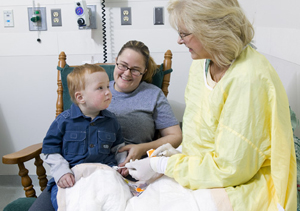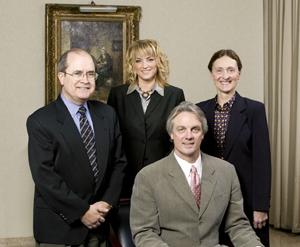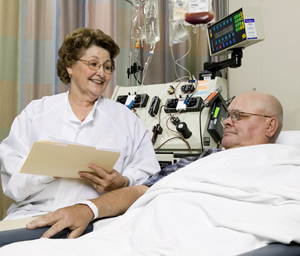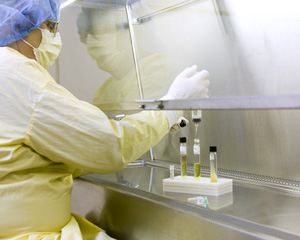 |
Braeden Martin and his mother, Stacey Martin, visit with Linda Wills, lead staff nurse, The Nebraska Medical Center, in the Cowdery Patient Care Center. |
The foundation has had a major impact worldwide in adults and children with cancer and other diseases.
The 16-member board of FACT, made up of representatives of blood and marrow transplant programs from across the U.S., will celebrate its 10th anniversary today with a bronze plaque dedication ceremony. The board is at UNMC this week for a two-day strategic planning retreat.
It was in 1996 that the Foundation was established at UNMC, thereby creating the world’s first comprehensive quality standards and inspection program for the safe collection, processing, and clinical administration of peripheral blood stem cells, bone marrow cells or cells from umbilical cord blood for use in transplantation.
The impetus for FACT began more than 10 years ago. UNMC faculty involved included Phyllis Warkentin, M.D., professor of pathology/microbiology and pediatrics, James Armitage, M.D., professor of medicine, Anne Kessinger, M.D., professor of medicine, Peter F. Coccia, M.D., professor and vice chairman of pediatrics. Other organizers were founding members of the American Society of Blood and Marrow Transplantation (ASBMT), the professional group of clinical experts in oncology and transplantation.
 |
Some FACT officers were on campus about two weeks ago to organize the strategic planning retreat happening this week. (From left to right) Alan Leahigh, chief executive officer, Linda Miller, chief operating officer, Phyllis Warkentin, M.D., medical director, and sitting is C. Fred LeMaistre, M.D., president. |
Both organizations had developed standards. The ASBMT standards focused on clinical patient care, physician training and the transplantation of cell products. The ISCT covered the collection, processing and storage of peripheral blood stem cells, bone marrow cells and umbilical cord blood.
|
They include Peter F. Coccia, M.D., Alfred Grovas, M.D., Marcel DeVetten, M.D., and John D. Jackson, Ph.D. Two American Red Cross Midwest Region Blood Services staff also serve as inspectors: Ramakrishna Reddy, M.D. and Lynda Thoreen. “Being an accreditation program inspector for FACT is an excellent learning experience. By surveying other major stem cell transplant programs, you get numerous ideas for quality improvement of your own program,” said Dr. Coccia, Ittner Professor, vice-chairman of the UNMC Department of Pediatrics and chief of the section, Pediatric Hematology/Oncology. “The FACT accreditation process has led to quality improvement in our program and improved patient safety.” Dr. DeVetten, hematologist/oncologist and director of the UNMC Blood and Marrow Transplantation Program, said the time he invests as a volunteer inspector is valuable. “It’s a time commitment I’m happy to make because FACT critically depends on members of the transplant community inspecting each other. FACT could not exist without volunteer inspectors. FACT accreditation means patients get the same benefits they always get when using a credentialed provider — assurance that the program adheres to high standards that have been developed to optimize patient safety and transplant outcomes,” he said. |
Dr. Warkentin was asked to lead the accreditation program. In July 1996, FACT was established at UNMC through the voluntary efforts of transplant specialists across the U.S.
“We started the program from scratch, developed and published the standards, set up the structure and guidelines for the accreditation process, the training of inspectors, and what inspectors should look for,” she said.
Subsequently, the national office was established with Linda Miller, now the chief operating officer, and Pam Welch, administrative assistant. The office is located near 69th and Dodge streets.
“Today there are eight employees with expertise in transplantation who advise program personnel in the accreditation process, schedule on-site inspections, prepare reports and do whatever is needed to support the work of the Foundation,” Dr. Warkentin said. “It’s a lot of work to get accredited, but the staffs at accredited transplant programs say they have a better program because of FACT. It’s a quality management system that has us always looking at what we do and how we can do things better.”
Dr. Warkentin, medical director, Transfusion and Transplantation Laboratories, The Nebraska Medical Center, also is board-certified in pediatric hematology/oncology and has been active in clinical transplantation. She said she is driven by interest in quality care for all patients.
“It’s really important for patient care. You want the whole program to do well. In the lab, we’ve always had inspections so we’re used to that. To bring the same amount of discipline to clinical medicine is an important step because it focuses the improvements back to the patient.”
She said there are 237 programs registered for accreditation, with 150 accredited and 87 are in the process of attaining the three-year accreditation. She said 109 programs have been accredited a second time and some a third time, representing about 92 percent of the hematopoietic blood and marrow transplant centers in the U.S.
 |
(From left to right) Rose Klein, a nurse for the America Red Cross, Midwest Region, collects peripheral blood stem cells from Larry Peterka of Wausa, Neb., in the apheresis room located in the Lied Transplant Center. |
Dr. Warkentin said accreditation also is used as an important measure of quality for transplant programs. Increasingly, health insurance plans, managed care organizations and state and federal government programs recognize or require FACT accreditation for patient care reimbursement or for designation as a center of excellence. Patients, too, quickly learn about accreditation and look for FACT approval when participating in decisions about their health care.
Patients in the U.S. aren’t the only ones who benefit from the FACT standards.
In 1999, the standards were adopted for blood and marrow transplant programs throughout Europe by the Joint Accreditation Committee of International Society for Cellular Therapy and the European Group on Blood and Marrow Transplantation. FACT has also developed standards and an accreditation program for cord blood banks worldwide.
“The goal of international standards in this area is to raise the bar of quality for everybody. The standards are about clinical care, quality management, personnel training that meets certain standards and teams working together well to provide high quality medical and laboratory practice in transplantation,” Dr. Warkentin said.
 |
Howard Julius, working in The Nebraska Medical Center Transfusion and Transportation Laboratories. |
“The idea is that you want the transplant program to be someplace you would take your own child or family member. We want to help all programs get to that level. Those working in the field of transplantation programs have a genuine desire to provide the best care for their patients,” she said.